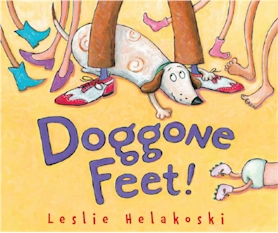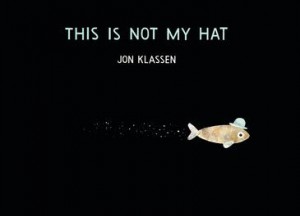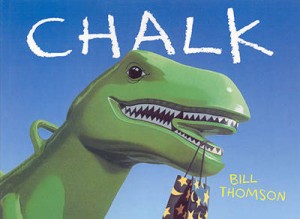Doggone Feet is Doggone Fun!
 There are many perks to being a children’s librarian (no overdue fines has saved me a bundle over the years) but one of the best parts of my job is getting to know supah-cool authors and illustrators like Leslie Helakoski. Leslie is a Michigan treasure I’ve had the pleasure of knowing for years, and I’m geeked to share her brand new book with you: Doggone Feet.
There are many perks to being a children’s librarian (no overdue fines has saved me a bundle over the years) but one of the best parts of my job is getting to know supah-cool authors and illustrators like Leslie Helakoski. Leslie is a Michigan treasure I’ve had the pleasure of knowing for years, and I’m geeked to share her brand new book with you: Doggone Feet.
Dog follows a pair of feet home from the park one day and finds her perfect place under the table. Life is good until two more feet come on the scene:
“They’re twirling leg twisters, toe-tapping kiss-kissers,
rule-listing insisters of doggy shampoos.”
So now the space under the table includes the dog and two sets of two feet, until another pair come along – tiny baby feet. As the family grows the dog must accommodate more pairs of feet in her shrinking space, and she’s not sure she likes the new additions. In the end, though the space under the table is crowded and cramped, the message is clear: families always make room for more.
The first time I read this book, I immediately thought how it perfect it would be for a math lesson. If there were two dogs and three humans, how many feet would be under the table? It’s also a great book to talk about point of view – both figuratively and literally. The story is told from the dog’s perspective, and we don’t see the faces of the humans, just their feet, until the end of the book. You can talk with your students about author/illustrator’s Craft and Structure – why did Ms. Helakoski choose to frame all the illustrations from this different point of view? How might a mouse see life under a dinner table, or a fly over a school cafeteria table at lunchtime? It’d be fun to have students spend a writing session on the floor under their desks, to inspire them to write and draw from a different point of view.
Then I saw the terrific trailer that Leslie’s son, Connor, made for her book:
How cool would it be to combine book-trailer technology with a math lesson centered around Doggone Feet?! Using a free app like Educreations on the iPad or a program like iMovie on computers, students could make a mini-movie to retell the events of the story (check off Key Ideas and Details on your Common Core State Standards score card) either by drawing the action or physically acting it out, adding up the feet as you go. With all the wonderful rhyme and wordplay, it’d be great for Reader’s Theater! Doggone Feet will be so doggone much fun for your students!
For more information, please visit Leslie’s website at helakoskibooks.com.
Read MoreTwo Perfect “Picks” for Valentine’s Day: Porcupining and Hokey Pokey
This Valentine’s Day, I’d like to share with the readers I love (you!) some of the things I love: wonderful pun-packed picture books by my author-crush Lisa Wheeler and free, already-planned activities to make teaching those books super-easy.
Porcupining: a Prickly Love Story and Hokey Pokey: Another Prickly Love Story, both written by Lisa Wheeler and illustrated by Janie Bynum, feature one of my most-beloved picture book characters, Cushion the Porcupine. We first meet Cushion in Porcupining where he is looking for love in all the wrong places. This forlorn hero of the petting zoo finally finds true love with Barb, a hedgehog. Then, in Hokey Pokey, Cushion wants to make his beloved Barb happy by learning to dance. Asking a fox, a rabbit, and a chicken for dance lessons only leads to prickly situations, and once again Cushion seems stuck out of luck. But Barb proves to be the perfect pick for Cushion when she teaches him all the moves he needs, and together they dance the Hokey Pokey.
 Comparing and contrasting two stories with the same characters, same author, and/or same illustrator is a great way to teach the Common Core State Standard of Integrating Knowledge and Ideas. On her website lisawheelerbooks.com, Lisa has a free teacher’s guide to go with these books. Use the graphic organizer from the teacher guide for Porcupining (written by super-cool author Tracie Vaughn Zimmer) to compare the main character, the problem, the three ways the character tries to solve the problem, and the solution in both books. Then, print off the adorable recipe cards for Cushion Cookies (made by another super-cool author Hope Vestergaard) and your Valentine’s Day is set!
Comparing and contrasting two stories with the same characters, same author, and/or same illustrator is a great way to teach the Common Core State Standard of Integrating Knowledge and Ideas. On her website lisawheelerbooks.com, Lisa has a free teacher’s guide to go with these books. Use the graphic organizer from the teacher guide for Porcupining (written by super-cool author Tracie Vaughn Zimmer) to compare the main character, the problem, the three ways the character tries to solve the problem, and the solution in both books. Then, print off the adorable recipe cards for Cushion Cookies (made by another super-cool author Hope Vestergaard) and your Valentine’s Day is set!
“This Is Not My Hat” wins the Caldecott Medal!
 If you’re a kid-lit lover like me, you already know that This Is Not My Hat written and illustrated by Jon Klassen won the Caldecott Medal for 2012. (Were you huddled around your computer screen that morning, too, watching the live broadcast and squealing when your favorites were announced? Just me? Ok.)
If you’re a kid-lit lover like me, you already know that This Is Not My Hat written and illustrated by Jon Klassen won the Caldecott Medal for 2012. (Were you huddled around your computer screen that morning, too, watching the live broadcast and squealing when your favorites were announced? Just me? Ok.)
This Is Not My Hat is an ideal picture book to teach the Common Core Standard of Integrating Knowledge & Ideas: “Use information gained from the illustrations and words in a print or digital text to demonstrate understanding of its characters, setting, or plot” and “explain how specific aspects of a text’s illustrations contribute to what is conveyed by the words in a story (e.g., create mood, emphasize aspects of a character or setting).” The story told by the text is not exactly the same as the story told by the pictures. (Working on a lesson on inference? Grab this book!)
A little fish (the fellow you see on the cover) is narrating the story as he swims. “This hat is not mine,” he admits. He stole it from a big fish, and we see the big fish sleeping. “…(H)e probably won’t wake up for a long time,” says the little fish, and we see the same illustration of that big fish, but now his eyes are wide open. So all the words are from the little fish’s point of view, but we see in the illustrations what the little fish doesn’t realize – the big fish does realize his hat was stolen, does know who took it, and is out to get his hat back. The end shows the big fish with his tiny hat back on his head, and the little fish is nowhere to be seen. Anyone want to infer what happened in the end?
Kids who loved Klassen’s I Want My Hat Back will adore this book, and find similarities beyond the hat theme. So share This Is Not My Hat and compare the information gained from the illustrations to the information we get from the text, and then compare the two books, and you’ll have a double-whammy Integration of Knowledge & Ideas lesson! The endings for both books is left up to the reader to figure out. You can have students debate what they think happens at the end, and give reasons to support their position. Do any of your students think the little fish got away? If he did, what might happen next?
Because there are only three characters in This Is Not My Hat (little fish, big fish, and tattle-tale crab) it’s super-easy to make a Storybox with the book and either stuffed animals, puppets, or felt pieces of the characters for kids to retell the story. If you’re crafty, have kids make hats from brown paper bags (keeping with Klassen’s muted tones) for them to swap and declare, “This is not my hat!”
Read MoreGot a new device? Play with “Chalk”!
If you were lucky enough to get an iPad, a Kindle, or some other fun e-gizmo this holiday season, and you’d like your kids to use it for more than just throwing (understandably) angry birds, get yourself some Chalk.
Chalk by Bill Thomson is a visually stunning wordless picture book available as a Kindle e-book. (If you have a tablet or an iPad, you can download the Kindle app for free and read Kindle books – cool, huh?) Three children find a bag of chalk on a playground. The things they draw come to life. When one of the children draws a dinosaur, how will the children stop it?
Wordless books like Chalk are a great choice for young readers, and not just because they can “read” the pictures to get the whole story. When children read a wordless book with adults, typically the language the adults use to describe what is happening in the illustrations is of a more complex nature than the sentences and vocabulary usually found in picture books for young ones. (Want to know more? Read my article about wordless picture books for ReaderKidZ.com) So a wordless book can actually work well to teach the Common Core State Standard of Craft & Structure. I love that Chalk offers a great opportunity for problem-solving. When the dinosaur comes to life on the playground in the story, you can ask your young readers, “What would you do?” Kids can brainstorm how they’d solve the problem and discuss Thomson’s solution – the child who drew the dinosaur draws a rain cloud, which becomes real and washes all the chalk (including the dinosaur) away. Talk through the problem and the solution, the beginning-middle-end, and you’re hitting Key Ideas and Details as well!
After you’ve enjoyed Chalk on your device, pair up students and have them sit back to back. If you have a classroom set of iPads, you can use a free drawing app like My Blackboard, or you can go old-school and use real chalk and construction paper, dry erase markers and white boards, etc. Have each student draw something that, if it came to life, would cause a huge problem. Then, students swap pictures and draw something that can then solve that problem.
So, tech it up with your students with the Kindle book and a fun, free app, or embrace the paper and get the book from your local library, but either way, don’t miss out on Chalk!
For more information, please visit billthomson.com.
Read More









